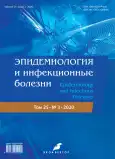Заболеваемость бруцеллёзом в Республике Дагестан в 2019 г.
- Авторы: Шахмарданов М.З.1, Абусуева А.С.2, Никифоров В.В.1, Томилин Ю.Н.1, Бурова С.В.1
-
Учреждения:
- Российский национальный исследовательский медицинский университет им. Н.И.Пирогова
- Дагестанский государственный медицинский университет
- Выпуск: Том 25, № 3 (2020)
- Страницы: 112-116
- Раздел: ОРИГИНАЛЬНЫЕ ИССЛЕДОВАНИЯ
- URL: https://journal-vniispk.ru/1560-9529/article/view/50362
- DOI: https://doi.org/10.17816/EID50362
- ID: 50362
Цитировать
Полный текст
Аннотация
Обоснование. В настоящее время бруцеллёз продолжает представлять серьёзную проблему для здравоохранения и сельского хозяйства России. В Российской Федерации в 2019 г. количество заболевшего бруцеллёзом крупного рогатого скота (КРС) увеличилось на 14%, а число впервые выявленных неблагополучных пунктов по бруцеллёзу коз и овец (КО) ― на 52%. Эпизоотии среди КРС и КО регистрируются преимущественно на территориях Северо-Кавказского и Южного федеральных округов, а максимальное число случаев вновь выявленного бруцеллёза среди людей зафиксировано в Республике Дагестан (РД).
Цель исследования ― характеристика заболеваемости бруцеллёзом в РД в 2019 г. и оптимизация профилактических мероприятий.
Материал и методы. В работе использованы предоставленные ГБУ РД «Республиканский центр инфекционных болезней, профилактики и борьбы со СПИДом имени С.М. Магомедова» и Управлением Федеральной службы по ветеринарному и фитосанитарному надзору РД сведения о состоянии заболеваемости бруцеллёзом, механизмах, путях, факторах передачи возбудителя, противоэпидемических мероприятиях при данной инфекции в РД в 2019 г. Применены статистический и эпидемиологический методы исследования.
Результаты. В 2019 г. на территории РД было зарегистрировано 163 новых случая бруцеллёза, что на 52 (+47%) случая больше, чем за аналогичный период 2018 г.; достоверно увеличилось число впервые выявленных больных с хроническим бруцеллёзом (р < 0,05). Чаще заболевали лица старше 41 года, преобладали мужчины (135; 82,8%); среди заболевших сельские жители составляли 84,2%, владельцы личного скота ― 56,1%. Бруцеллёз зарегистрирован на 40 территориях РД, при этом в сельской местности случаев заражения в 6 раз выше, чем в городской. Источником заражения для людей в 58,8% случаев были КО, в 41,2% ― КРС. Показано, что ведущим фактором сохраняющейся высокой заболеваемости бруцеллёзом в РД являются неудовлетворительные обследование и специфическая профилактика среди КРС и КО.
Заключение. Таким образом, эпизоотологическую и эпидемиологическую ситуацию по бруцеллёзу в РД в настоящее время следует считать нестабильной. Прогноз ситуации на ближайшие годы, а также уровень заболеваемости бруцеллёзом среди животных и людей будет зависеть от полноты реализации планов по профилактике данного заболевания.
Ключевые слова
Полный текст
Открыть статью на сайте журналаОб авторах
Мурад Зияудинович Шахмарданов
Российский национальный исследовательский медицинский университет им. Н.И.Пирогова
Автор, ответственный за переписку.
Email: mshakhmardanov@yandex.ru
ORCID iD: 0000-0002-3168-2169
SPIN-код: 3312-4052
д.м.н., профессор
Россия, 117997, г. Москва, ул. Островитянова, д. 1Аида Сагадуллаевна Абусуева
Дагестанский государственный медицинский университет
Email: amur39@mail.ru
ORCID iD: 0000-0002-6999-1696
SPIN-код: 4713-7110
к.м.н., доцент
Россия, МахачкалаВладимир Владимирович Никифоров
Российский национальный исследовательский медицинский университет им. Н.И.Пирогова
Email: v.v.nikiforov@gmail.com
ORCID iD: 0000-0002-2205-9674
SPIN-код: 9044-5289
д.м.н., профессор
Россия, 117997, г. Москва, ул. Островитянова, д. 1Юрий Николаевич Томилин
Российский национальный исследовательский медицинский университет им. Н.И.Пирогова
Email: papa220471@mail.ru
ORCID iD: 0000-0003-2767-4868
SPIN-код: 8938-2621
к.м.н.
Россия, 117997, г. Москва, ул. Островитянова, д. 1Светлана Васильевна Бурова
Российский национальный исследовательский медицинский университет им. Н.И.Пирогова
Email: svburova@list.ru
ORCID iD: 0000-0001-7664-7685
SPIN-код: 9165-2625
к.м.н., доцент
Россия, 117997, г. Москва, ул. Островитянова, д. 1Список литературы
- Сафонов А.Д., Пневский Ю.А., Нурпейсова А.Х. Бруцеллез ― актуальная зоонозная инфекция на территории Омской области // Эпидемиология и инфекционные болезни. 2017. Т. 22, № 3. С. 134–138. doi: 10.18821/1560-9529-2017-22-3-134-133
- Пономаренко Д.Г., Русанова Д.В., Хачатурова А.А., и др. Анализ эпидемической и эпизоотической ситуации по бруцеллезу в мире в 2019 г. и прогноз на 2020 г. в Российской Федерации // Проблемы особо опасных инфекций. 2020. № 2. С. 48–56. doi: 10.21055/0370-1069-2020-2-48-56
- Микаилов М.М., Юсупов О.Ю., Халиков А.А., и др. Об эпизоотической ситуации по бруцеллезу животных в Республике Дагестан и мерах по ее стабилизации // Ветеринарная патология. 2019. № 3. С. 5–11. doi: 10.25690/VETPAT.2019.69.39587
- Курбонов К.М., Симонова Е.Г., Филатов Н.Н. Особенности сезонности бруцеллеза среди населения Республики Таджикистан // Журнал микробиологии, эпидемиологии и иммунобиологии. 2019. № 1. С. 63–66. doi: 10.36233/0372-9311-2019-1-63-67
- Кулаков Ю.К. Молекулярные механизмы персистенции возбудителя бруцеллеза // Журнал микробиологии, эпидемиологии и иммунобиологии. 2018. № 4. С. 68–76. doi: 10.36233/0372-9311-2018-4-68-76
- Гусниев А.М., Билалова С.К., Абусуева А.С., и др. Под маской бруцеллеза // Вестник Дагестанской государственной медицинской академии. 2018. № 1. С. 64–66.
- Управление Федеральной службы по ветеринарному и фитосанитарному надзору РД [интернет]. Наложение (снятие) карантина по заразным болезням сельскохозяйственных животных и птиц на территории Республики Дагестан в 2019 г. Режим доступа: http://rsnrd.ru/?id=1373475819/1375644067. Дата обращения: 12.06.2020.
Дополнительные файлы






